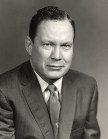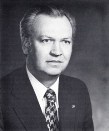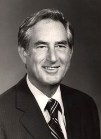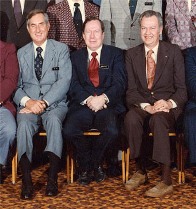National Cemetery Administration
Directors & Under Secretaries for Memorial Affairs, 1973 to Present (1 of 5)

Rufus Harold Wilson
Chief Memorial Affairs Director
National Cemetery System
Veterans Administration
(1974–1975)
Rufus H. Wilson was the first person to head the Veterans Administration (VA) National Cemetery System (NCS) when he became Chief Memorial Affairs Director, on February 8, 1974, during the administration of President Richard Nixon.
Following passage of the National Cemeteries Act of 1973, Wilson oversaw the VA's takeover of the 82 cemeteries and 1,000 employees that until September 1, 1973, had been assigned to the Department of the Army. The act addressed the problem of historically haphazard development of national cemeteries, and distribution that did not correlate to veteran population; this was exacerbated by the fact that existing cemeteries were quickly filling up, too. At the same time, VA took over the government headstone and marker program. As a result of the demand, during its first years of national cemetery operation, VA adopted the "Regional Cemetery Concept," which stipulated that each of the ten standard Federal regions would have one primary new or expanded national cemetery to serve veterans in need of burial services.
Wilson devoted his entire working career to veterans. He received the coveted National Civil Service League Career Service Award and the Exceptional Service Award in 1975 for his work. Wilson left the position of Chief Memorial Affairs Director in January 23, 1975, to retake the position of Chief, Benefits Director.
The Tennessee-born Wilson served as a special assistant to the Administrator of VA before his election as National Commander of AMVETS in 1954—the youngest man to lead that organization. He rejoined VA in 1955 working in the Department of Veterans Benefits, then the Congressional Liaison Service. He later served as director of regional offices in St. Petersburg, FL; Lincoln, NE.; and Baltimore, MD. He was the Chief, Benefits Director, in 1969, and the following year became Associate Deputy Administrator.
Wilson joined the Marines and served in World War II, from 1943 to 1945, when he was critically injured at Saipan. He was awarded two Purple Hearts, two Battle Stars, and a Unit Citation.

John W. Mahan
Director
National Cemetery System
Veterans Administration
(1975–1977)
John W. Mahan served as the Director of the National Cemetery System (NCS) from January 27, 1975, through January 28, 1977, during the administration of President Gerald Ford. Prior to this appointment, Mahan was the Acting Director of NCS, starting in August 1973, and was named Deputy Director in February 1974.
Mahan served in these key leadership positions during a period of rapid transition, as 82 national cemeteries and affiliated soldiers lots were being transferred from the Army to what was then the Veterans Administration. After many years of inactivity in the domain of cemetery expansion, and a resulting shortage of burial space for future needs, Mahan oversaw the establishment of five of the largest national cemeteries in the history of the agency.
The placement of the new generation of national cemeteries reflected population centers of veterans across the country: Calverton National Cemetery at Calverton, NY; Indiantown Gap National Cemetery at Annville, PA; Massachusetts National Cemetery at Bourne, MA; Riverside National Cemetery at Riverside, CA; and Quantico National Cemetery at Triangle, VA. In 1976, a commemorative headstone was introduced for recipients of the nation's highest award for valor, the Medal of Honor, featuring the inscription in gold leaf.
Mahan joined the Veterans Administration in 1973. Until 1965, when he entered public service, he maintained a private law practice in his hometown of Helena, MT. In 1965, President Lyndon Johnson appointed Mahan to the chairmanship of the Subversive Activities Control Board, and he was reappointed to the same position by President Nixon, for a total of eight years. Mahan served in the Marine Corps, including duty in World War II as a dive-bomber pilot in the South Pacific, and attained the rank of major (USMC-Retired). In 1949, he received a law degree from the University of Montana, by means of the GI Bill. He was elected Commander-in-Chief of the Veterans of Foreign Wars in 1958.

Carl Thomas Noll
Director
National Cemetery System
Veterans Administration
(1977–1981)
Carl T. Noll was Director of the National Cemetery System (NCS) under President Jimmy Carter, starting May 9, 1977, and remained in this position until his death on January 27, 1981. Noll held the distinction of serving the cemetery program in key leadership positions under both military and civilian jurisdictions. From 1962 to 1972, he was Deputy Chief and, later Chief, of the Army's Memorial Division within the Office of the Chief of Support Services. Subsequently, he was named Executive Director of the newly established Army Memorial Affairs Agency.
When NCS was established in 1973, Noll joined the Veterans Administration (VA) as Executive Assistant to the NCS Director. Almost immediately, 82 Department of the Army cemeteries were transferred from military to civilian management under VA. Noll was named Deputy Director of NCS in 1975.
Noll's leadership encompassed the first realization of the cemetery system expansion in decades, including the opening of 740-acre Riverside National Cemetery, CA; Calverton National Cemetery, NY, at more than 900 acres; and Massachusetts National Cemetery, Bourne, MA, at almost 750 acres. All three reflect the first generation of expansive, modern cemetery landscapes generated through VA. Noll inaugurated a valuable new initiative, the State Cemetery Grants Program. The State Grants program was authorized in 1978 to assist states to provide burial sites for veterans in areas where VA's national cemeteries could not. The first project, funded two years later, was awarded to the State of Maryland for improvements at the Eastern Shore Veterans Cemetery.
Noll was a Pennsylvania native who attended Eckles College in Philadelphia, and George Washington University. During World War II he served in the Army in the China-Burma-India theatre, retiring as a major. After the war, Noll participated in planning the program for repatriating U.S. war dead to the United States. In 1970, Noll received the Exceptional Civilian Service Award from the Secretary of the Army for his work with the National Cemetery System. He is interred at Arlington National Cemetery.

Three Directors of the National Cemetery System (NCS) — past, present and future (left to right): Carl T. Noll, Deputy Director and eventually the third Director of NCS; Rufus Harold Wilson, Chief, Benefits Director and first Chief Memorial Affairs Director of NCS; and John W. Mahan, second Director of NCS. Photograph taken December 16–19, 1974, in San Francisco.

















